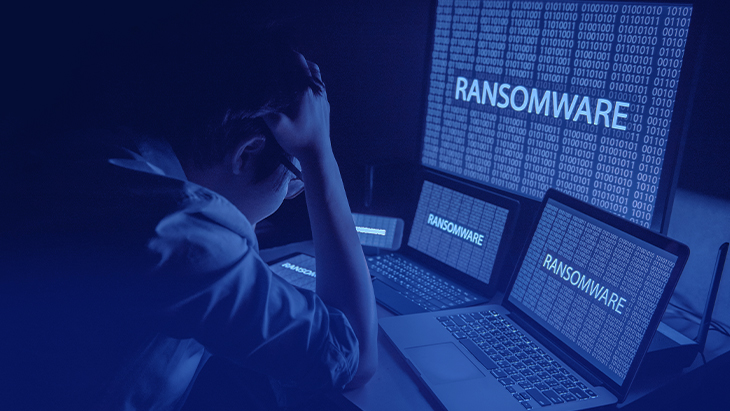
The Anatomy of a Ransomware Attack
Cyber attacks are one of the most adverse outcomes of the same digital technologies that also provide us with countless benefits. Cyber attack vectors that seriously threaten different elements of cyber security systems, especially IT networks, are capable of causing significant damage to organizations. One of these vectors posing a major threat to data security is ransomware attacks.
Ransomware is a type of malware attack that cyber attackers infiltrating organizations' IT networks and databases use to demand a ransom in return for the captured data. Emerging as individual cyber threat actors in the early years of the digital transformation era, these attacks have now evolved into a global and indiscriminate ransomware-as-a-service (RaaS) model that can target organizations across multiple sectors.
This cyber threat plays an important role in the attacks targeting facilities that store important personal data, such as hospitals and healthcare centers. Trading on the idea of capturing masses of data from these organizations through a ransomware attack, cyber attackers seek to maximize profit by exploiting access security vulnerabilities.
The data in Verizon's Data Breach Investigations Report does a good job of showing the great lengths to which ransomware attackers have gone recently. According to the report, the number of ransomware attacks has increased by about 13% this year. This increase is almost as big as the last five years combined. Moreover, about 70% of data breaches caused by malware attacks are ransomware attacks.
Stages of Ransomware Attacks
A ransomware attack consists of 6 basic stages. A hacker can achieve the desired result by following the steps below when conducting a ransomware attack. Before addressing what can be done to prevent the progression of these phases and eliminate the attack vector, it would be helpful to look at them in more detail.
- Campaign
It refers to the method the cyber attacker uses to deliver a ransomware attack. These methods include remote exploits on web servers, weaponization of websites, and malicious emails. Having become a systematic social engineering attack, malicious emails are one of the most common methods. With this method, the attacker forces users to download malicious software unwittingly.
- Infection
At this stage, the malicious code or code block prepared by the cyber attacker starts to spread through the targeted IT network. If the malware is detected as it spreads, and the necessary actions are taken in a short amount of time, there might be a chance to recover the passwords.
- Staging
At this stage, the attacker tries to embed the ransomware into the system he is infiltrating by making minor changes to the cyber attack vector he has prepared. Unlike the infection stage, there is communication between the ransomware and C2 server, which protects the encryption key in the staging phase.
- Scanning
It occurs when the ransomware starts scanning the IT network to identify the files to encrypt. It is an important stage for the cyber attacker to achieve the intended results, because the authorized access definitions and permission levels in your system determine the path the attacker can take after scanning.
- Encryption
Once the scanning is complete, the encryption process is initiated. Local files on your IT network are encrypted within seconds, then the ransomware moves to the cloud, and shared files on the network. Data on the network is encrypted and copied. Finally, the copied and encrypted data is uploaded again to replace the original files on the network.
- Remuneration
Once the cyber attacker captures important data, he sends a ransom note to network users' accounts, specifying the payment amount and details. Sometimes the attackers set a deadline, and the ransom increases over time. Sometimes, hackers even offer a customer service line for their victims to discuss the payment terms. However, there is no guarantee of recovering the data, even if you pay the ransom using the required payment method.
Defense Mechanisms Against Ransomware Attacks
Now that we have detailed each stage of a ransomware attack, let's take a closer look at how you can protect yourself from this attack vector.
- Restrict privileged access
Design your privileged access mechanism based on the principle of zero trust. Limit the number of users in the domain administrator group and control the movements of these users on the IT network.
- Protect privileged accounts
Privileged accounts are the most important component of your defenses against ransomware attacks. By using privileged access management (PAM) solutions with advanced password protection and auditing modules, you can ensure a high level of protection for privileged account credentials.
- Secure Active Directory
Eliminate domains with questionable security even if they are considered secure by the organization. Establish an advanced auditing mechanism to ensure that required domain activities are performed in accordance with cyber security protocols.
- Eliminate lateral movement paths
Eliminate lateral movement paths through SMB, RPC, and RDP network segmentations.
- Prevent phishing threats
Design a system that detects and blocks malicious emails before they reach users. Using advanced email security software that can detect such emails will make your job easier.
- Use patch management
Use a patch management application to prioritize the patches that are vulnerable to attacks on your IT network.
Minimize the Threat with Privileged Access Management Solutions
The key to minimizing the threat of ransomware attacks is to leverage Privileged Access Management solutions. Offering everything you need from authentication to password management to build an advanced cyber security infrastructure, PAM systems provide centralized control of all passwords. The system also makes it possible to store passwords of privileged accounts in encrypted vaults isolated from the IT network.
Our two-factor authentication feature requires simultaneous geo-location and time verification from the users attempting to log in to the network. Making access to the system more secure by sending limited-time passwords, this PAM module does not allow access to the system unless two-factor authentication is completed, which makes it hard to steal credentials on the network.
Moreover, our Privileged Session Manager module gives you 24/7 control over the sessions conducted by privileged accounts. The system manages the access of users with privileged access permissions to the network, allowing you to intervene immediately in the event of a data breach. Data masking, one of the advantages offered by our PAM solution, masks all critical data in the IT network and makes the processed data indistinguishable from real data. This prevents real data from being detected by a cyber attacker.
Our Privilege Access Management solution, Single Connect, offers the modules above, among others, to protect your organization against ransom attacks targeting privileged account credentials and the passwords of users with privileged access, as well as the critical data on the organization's network, bringing the attack to a halt.
For more information about Single Connect, one of the few leading PAM solutions available globally, contact our team with any questions.
Other Blogs













